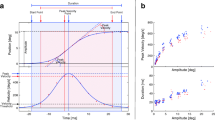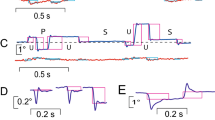Abstract
This work discusses a new approach for ataxia SCA-2 diagnosis based in the application of independent component analysis to the data obtained by electro-oculography in several experiments carried out over healthy and sick subjects. Abnormalities in the oculomotor system are well known clinical symptoms in patients of several neurodegenerative diseases, including modifications in latency, peak velocity, and deviation in saccadic movements, causing changes in the waveform of the patient response. The changes in the morphology waveform suggest a higher degree of statistic independence in sick patients when compared to healthy individuals regarding the patient response to the visual saccadic stimulus modeled by means of digital generated saccade waveforms. The electro-oculogram records of six patients diagnosed with ataxia SCA2 (a neurodegenerative hereditary disease) and six healthy subjects used as control were processed to extract saccades.
Preview
Unable to display preview. Download preview PDF.
Similar content being viewed by others
References
Virkkala, J., Hasan, J., Värri, A., Himanen, S.-L., Müller, K.: Automatic sleep stage classification using two-channel electro-oculography. Journal of Neuroscience Methods 166, 109–115 (2007)
Spicker, S., Schulz Jr., B., Petersen, D., Fetter, M., Klockgether, T., Dichgans, J.: Fixation instability and oculomotor abnormalities in Friedreich’s ataxia. Journal of Neurology 242, 517–521 (1995)
Yokota, T., Hayashi, H., Hirose, K., Tanabe, H.: Unusual blink reflex with four components in a patient with periodic ataxia. Journal of Neurology 237, 313–315 (1990)
Güven, A.l., Kara, S.: Classification of electro-oculogram signals using artificial neural network. Expert Systems with Applications 31, 199–205 (2006)
Irving, E.L., Steinbach, M.J., Lillakas, L., Babu, R.J., Hutchings, N.: Horizontal Saccade Dynamics across the Human Life Span. Invest. Ophthalmol. Vis. Sci. 47, 2478–2484 (2006)
Kumar, D., Poole, E.: Classification of EOG for human computer interface. In: Annual International Conference of the IEEE Engineering in Medicine and Biology - Proceedings, vol. 1, pp. 64–67 (2002)
Brunner, S., Hanke, S., Wassertheuer, S., Hochgatterer, A.: EOG Pattern Recognition Trial for a Human Computer Interface. Universal Access in Human-Computer Interaction. Ambient Interaction, 769–776 (2007)
Komogortsev, O.V., Khan, J.I.: Eye movement prediction by Kalman filter with integrated linear horizontal oculomotor plant mechanical model. In: Proceedings of the 2008 symposium on Eye tracking research & applications, pp. 229–236. ACM, New York (2008)
Bürk, K., Fetter, M., Abele, M., Laccone, F., Brice, A., Dichgans, J., Klockgether, T.: Autosomal dominant cerebellar ataxia type I: oculomotor abnormalities in families with SCA1, SCA2, and SCA3. Journal of Neurology 246, 789–797 (1999)
Orozco, G., Estrada, R., Perry, T.L., Araña, J., Fernandez, R., Gonzalez-Quevedo, A., Galarraga, J., Hansen, S.: Dominantly inherited olivopontocerebellar atrophy from eastern Cuba: Clinical, neuropathological, and biochemical findings. Journal of the Neurological Sciences 93, 37–50 (1989)
Velázquez, L.: Ataxia espino cerebelosa tipo 2. In: Principales aspectos neurofisiológicos en el diagnóstico, pronóstico y evaluación de la enfermedad. Ediciones Holguín, Holguín (2006)
Vaya, C., Rieta, J.J., Sanchez, C., Moratal, D.: Convolutive Blind Source Separation Algorithms Applied to the Electrocardiogram of Atrial Fibrillation: Study of Performance. IEEE Transactions on Biomedical Engineering 54, 1530–1533 (2007)
Klostermann, W., Zühlke, C., Heide, W., Kömpf, D., Wessel, K.: Slow saccades and other eye movement disorders in spinocerebellar atrophy type 1. Journal of Neurology 244, 105–111 (1997)
Anemüller, J.r., Sejnowski, T.J., Makeig, S.: Complex independent component analysis of frequency-domain electroencephalographic data. Neural Networks 16, 1311–1323 (2003)
Hyvarinen, A., Oja, E.: A Fast Fixed-Point Algorithm for Independent Component Analysis. Neural Computation 9, 1483–1492 (1997)
Cardoso, J.-F.: Source separation using higher order moments. In: Proceedings of ICASSP, IEEE International Conference on Acoustics, Speech and Signal Processing, vol. 4, pp. 2109–2112 (1989)
Rojas, F., Puntonet, C.G., Rodríguez-Álvarez, M., Rojas, I., Martín-Clemente, R.: Blind source separation in post-nonlinear mixtures using competitive learning, simulated annealing, and a genetic algorithm. IEEE Transactions on Systems, Man and Cybernetics Part C: Applications and Reviews 34, 407–416 (2004)
Author information
Authors and Affiliations
Editor information
Editors and Affiliations
Rights and permissions
Copyright information
© 2010 Springer-Verlag Berlin Heidelberg
About this paper
Cite this paper
García, R.V., Rojas, F., Puntonet, C.G., San Román, B., Velázquez, L., Rodríguez, R. (2010). Advances in Ataxia SCA-2 Diagnosis Using Independent Component Analysis. In: Solé-Casals, J., Zaiats, V. (eds) Advances in Nonlinear Speech Processing. NOLISP 2009. Lecture Notes in Computer Science(), vol 5933. Springer, Berlin, Heidelberg. https://doi.org/10.1007/978-3-642-11509-7_12
Download citation
DOI: https://doi.org/10.1007/978-3-642-11509-7_12
Publisher Name: Springer, Berlin, Heidelberg
Print ISBN: 978-3-642-11508-0
Online ISBN: 978-3-642-11509-7
eBook Packages: Computer ScienceComputer Science (R0)




